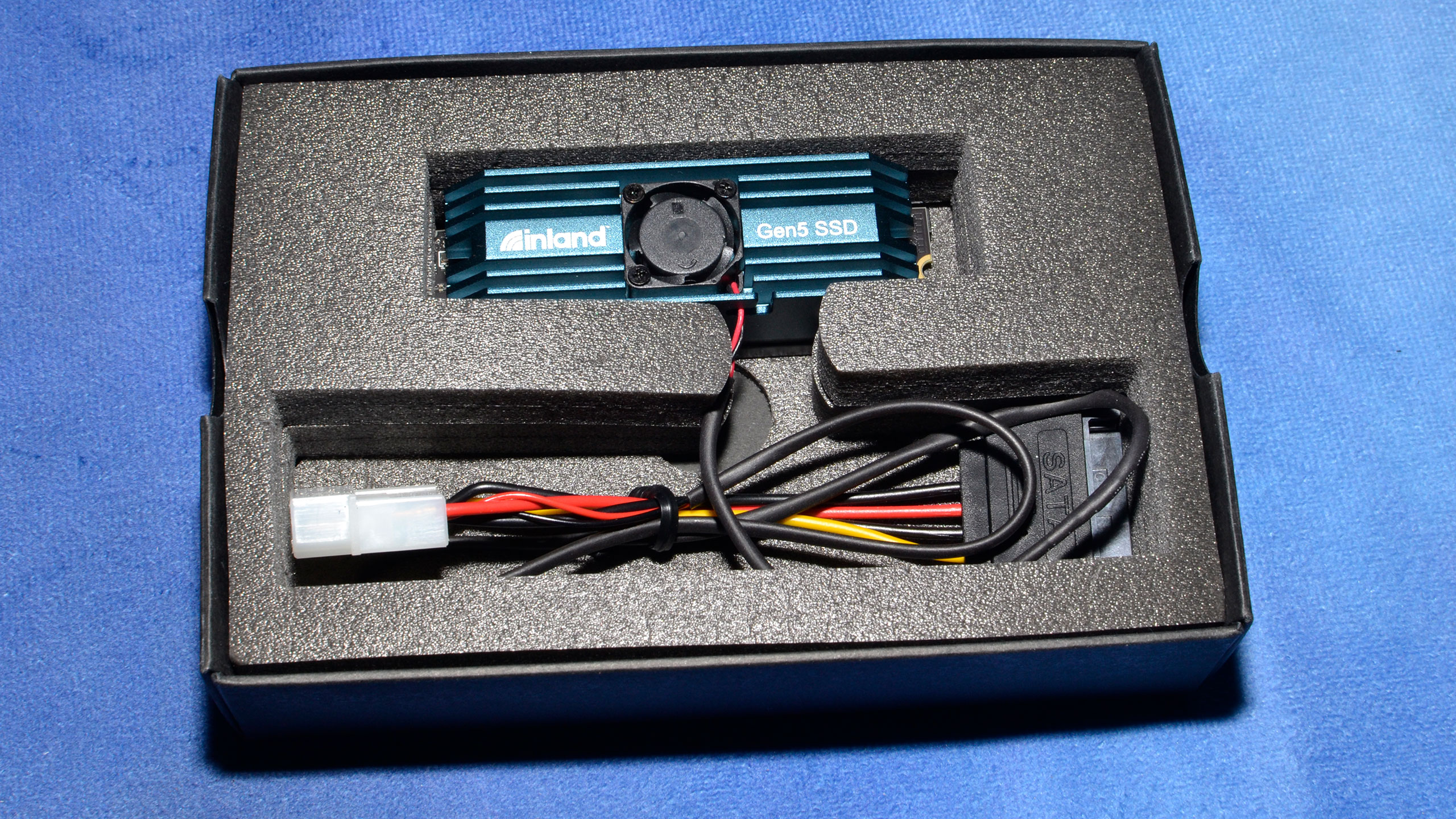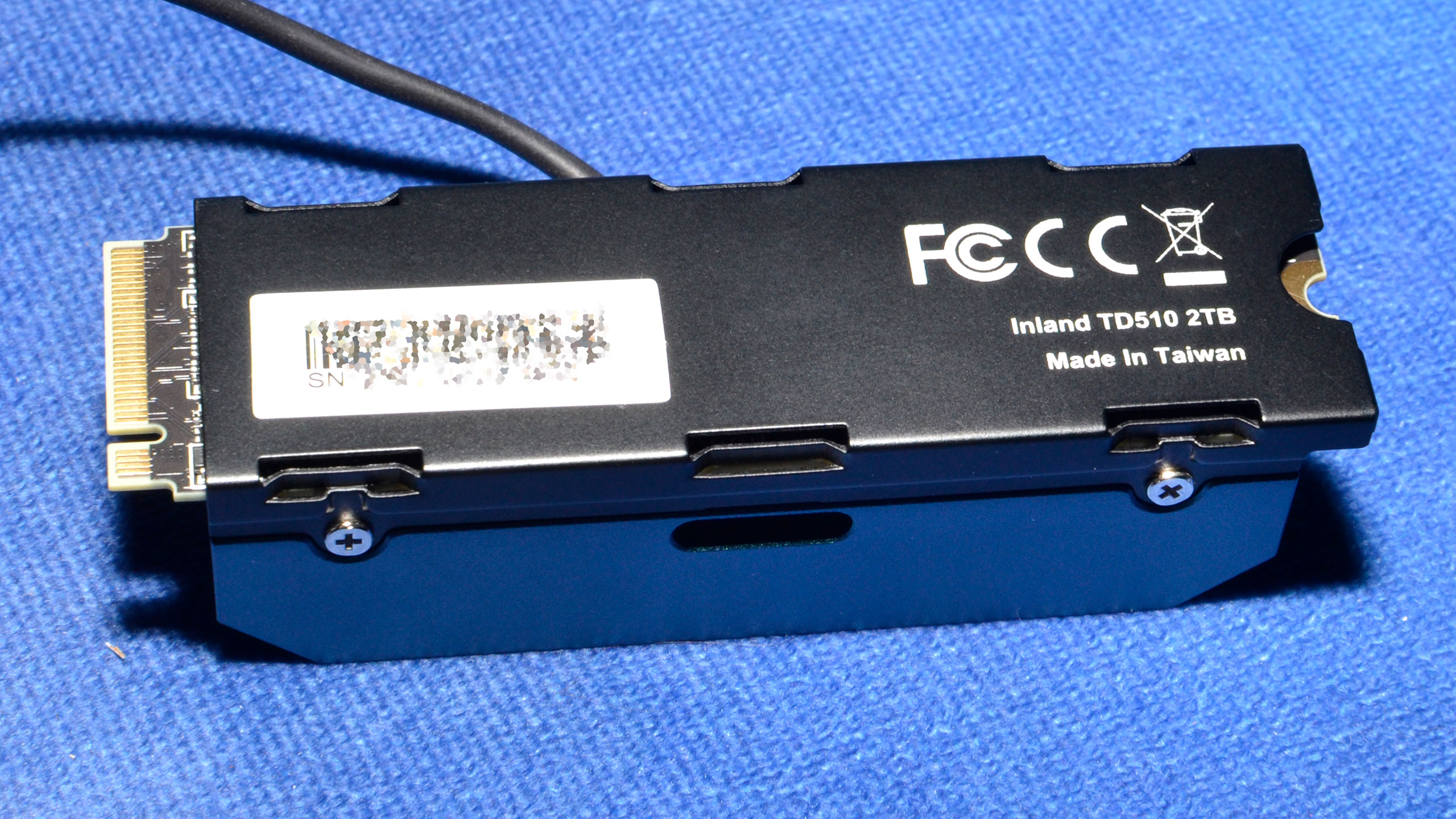Tom's Hardware Verdict
The Inland TD510 is the first PCIe 5.0 NVMe SSD available on the market, arriving before the main contenders at retail. It’s not earth-shattering, and there are better drives to come, but it is a nice early adopter treat.
Pros
- +
Fast, PCIe 5.0 bandwidth
- +
Good performance in random IOPS, sustained workloads
- +
Available without costing an arm and a leg
- +
DirectStorage-optimized
Cons
- -
Faster PCIe 5.0 drives are not too far behind
- -
Requires a PCIe 5.0 motherboard to take full advantage
- -
Performance gains are not massive on the whole
- -
Fan doesn't improve cooling
- -
Poor power efficiency
Why you can trust Tom's Hardware
They may be a little late, but the first crop of PCIe 5.0 SSDs have finally arrived at retail. The Inland TD510 is one of the first available and affordable models, and its leading-edge performance of 10GB/s of sequential read throughput and 1.5 million random read IOPS is a good indicator of what we can expect from the new wave of drives.
The Inland TD510 offers unprecedented bandwidth with a compatible system, and performance as a whole is quite good. The heatsink is sufficient but comes with a largely ineffective fan, and this basic reference design matches Inland’s no-frills approach to SSDs. There’s no extra software support, but you do get an extra year of warranty. The TD510 is a good choice for early adopters, but faster PCIe 5.0 drives are coming later this year. Let's see how the Inland TD510 fares in our test suite.
Specifications
| Product | 2TB |
|---|---|
| Pricing | $279.99 |
| Form Factor | M.2 2280 |
| Interface / Protocol | PCIe 5.0 x4 |
| Controller | Phison E26 |
| DRAM | DDR4 |
| Flash Memory | 232-Layer Micron TLC |
| Sequential Read | 10,000 MBps |
| Sequential Write | 9,500 MBps |
| Random Read | 1,500K |
| Random Write | 1,250K |
| Security | N/A |
| Endurance (TBW) | 1,400TB |
| Part Number | - |
| Warranty | 6-Year |
The Inland TD510 is currently only available at the 2TB capacity, but this is a perfectly reasonable amount of storage. A 4TB option would be nice, but 2TB is quite cost-effective, selling for $279.99 regularly and at the time of review. This carries a premium over high-end PCIe 4.0 SSDs, but it’s competitive for the new crop of 5.0 drives.
The drive can eke out up to 10,000 / 9,500 MBps for sequential read/write throughput and 1,500K / 1,250K for random read/write IOPS. This is on the lower end for 5.0 SSDs but still offers a bump over PCIe 4.0 SSDs. The TD510 is warrantied for 1400TB of written data, which is pretty standard, and it gets an extra year of warranty as Inland covers it for six years versus the standard five.
Software and Accessories
The Inland TD510 is a no-frills offering, so it comes with no software. The included reference heatsink is listed as removable, so you can use a motherboard’s M.2 heatsink instead. For software, we suggest the free CrystalDiskInfo for S.M.A.R.T. monitoring and Clonezilla for cloning.
A Closer Look



Removing the heatsink wasn’t quite as easy as the TD510’s packaging would have you believe. We surely don't recommend you attempt the process if you don't have to. The small fan is optional, and we recommend not plugging it in as it does not provide much in the way of improved cooling performance but does generate noise. This is because the reference heatsink doesn't have an air channel that allows the air to exit the small chamber underneath the fan.
Under the heatsink, we find an SSD controller, a DRAM package, and two NAND packages. There are two more NAND packages on the underside, for a total of four.
Get Tom's Hardware's best news and in-depth reviews, straight to your inbox.
The Phison E26 controller will become a familiar sight on PCIe 5.0 SSDs. Initial drives reach up to 10 GB/s, but future models can go higher, as with the Crucial T700. This controller is often paired with 4GB of LPDDR4. This is twice the typical amount of DRAM, and this type of memory is more efficient than DDR4.
NV066 is the FBGA code for 4Tb of Micron’s 232-Layer TLC (B58R). Each package is in a quad die configuration (QDP) for an overall total of 2TB. It should be possible to achieve up to 8TB with this layout.
MORE: Best SSDs
MORE: Best External SSDs and Hard Drives
MORE: How We Test HDDs And SSDs
MORE: All SSD Content

Shane Downing is a Freelance Reviewer for Tom’s Hardware US, covering consumer storage hardware.
-
Li Ken-un Lol really? This is a strike against a PCIe 5.0 device?Reply
Requires a PCIe 5.0 motherboard to take full advantage
It’s like “food; cons: * requires tastebuds to enjoy.” -
Avro Arrow Yeah, I'm not going to pay that much for an NVMe drive that requires active cooling which doesn't even work properly.Reply
My primary use for SSDs is game-loading. For that task, the difference between SATA-III and PCI-Express v4.0 is nigh imperceptible. Therefore, PCI-Express v5.0 wouldn't do anything except bleed my wallet dry. -
johnwkuntz Reply
Shane, I have to ask,,,are you deaf as a fence post? I bought the drive and after one evening in a Fractal Pop Air case I had to swap out the heatsink for this...Admin said:The Inland TD510 is the first accessible baseline PCIe 5.0 NVMe SSD, and it’s been priced aggressively. This makes it the first chance at getting this type of bandwidth for your desktop.
Inland TD510 SSD Review: The First Widely Available PCIe 5.0 SSD : Read more
Warp Shield Hhttps://www.wizmaxglobal.com/products/CATEGORY_ACCESSORIES/WARP-SHIELD-HNot only is the fan on the stock heatsink ineffective, It is unbelievably loud, How can something that small make that much noise? BTW I think this heatsink might also do the trick for those wanting something a tad smaller... https://www.wizmaxglobal.com/products/CATEGORY_ACCESSORIES/WARP-SHIELD-SYou just basically want something cooling both faces of the drive. Both are fairly cheap on Amazon. -
terroralpha ReplyAvro Arrow said:Yeah, I'm not going to pay that much for an NVMe drive that requires active cooling which doesn't even work properly.
My primary use for SSDs is game-loading. For that task, the difference between SATA-III and PCI-Express v4.0 is nigh imperceptible. Therefore, PCI-Express v5.0 wouldn't do anything except bleed my wallet dry.
i got this SSD as a warranty replacement for a dead gen 4 inland SSD. it doesn't need the active cooling. the is a meme to make the SSD seem more "1337 gAm3r" for the kids who don't know any better.
i'm using the SSD heatsink that came with my asus X670E-E, and it works fine. i use this computer for work and gaming. it's on about 10 hours a day mon-fri. no issues in 5+ months of use. -
Avro Arrow Reply
It really blows my mind how these "current-gen" NVMe drives can get so hot when they're often not even being used at their top-rated speeds. It tells me that they're not overly-efficient.terroralpha said:i got this SSD as a warranty replacement for a dead gen 4 inland SSD. it doesn't need the active cooling. the is a meme to make the SSD seem more "1337 gAm3r" for the kids who don't know any better.
i'm using the SSD heatsink that came with my asus X670E-E, and it works fine. i use this computer for work and gaming. it's on about 10 hours a day mon-fri. no issues in 5+ months of use. -
Order 66 Reply
I would say I disagree, because I do notice faster loading times going from my old system with a SATA SSD to my new system with an NVME SSD, but most of that is probably because I also went from an i5 6500 to a 7700x, and from an RX 550 to an RX 6800. I will say I do notice faster file copying speeds though, which is huge for me as I like to play games with mods, and some mods can be fairly large.Avro Arrow said:Yeah, I'm not going to pay that much for an NVMe drive that requires active cooling which doesn't even work properly.
My primary use for SSDs is game-loading. For that task, the difference between SATA-III and PCI-Express v4.0 is nigh imperceptible. Therefore, PCI-Express v5.0 wouldn't do anything except bleed my wallet dry. -
Avro Arrow Reply
Yeah, it can make a difference in file-copying but I don't do that very often. The copies that I do make are generally game files moved over to one of my 8TB hard drives so that I only ever have to download a game once. If I feel like playing an older game that I haven't played in awhile, I just copy it back over. Sure, it might not be as fast as using a PCIe5 NVMe drive, but it's blazingly fast compared to downloading it from Steam again! :LOL:Order 66 said:I would say I disagree, because I do notice faster loading times going from my old system with a SATA SSD to my new system with an NVME SSD, but most of that is probably because I also went from an i5 6500 to a 7700x, and from an RX 550 to an RX 6800. I will say I do notice faster file copying speeds though, which is huge for me as I like to play games with mods, and some mods can be fairly large.
They also don't get hot enough to do any damage to themselves or anything else and to me, that's a much bigger plus than having some extra speed. My system drive is a WD Black SN770 512GB PCIe4 NVMe and it gets noticeably hotter than any of my PCIe3 NVMe drives. I had a Lexar 2TB drive burn itself out and even though it was a PCIe3 NVMe, it made me pretty cautious about things like that. If a drive needs active cooling, I don't need that drive.


